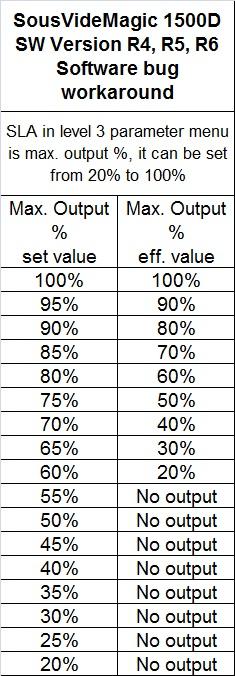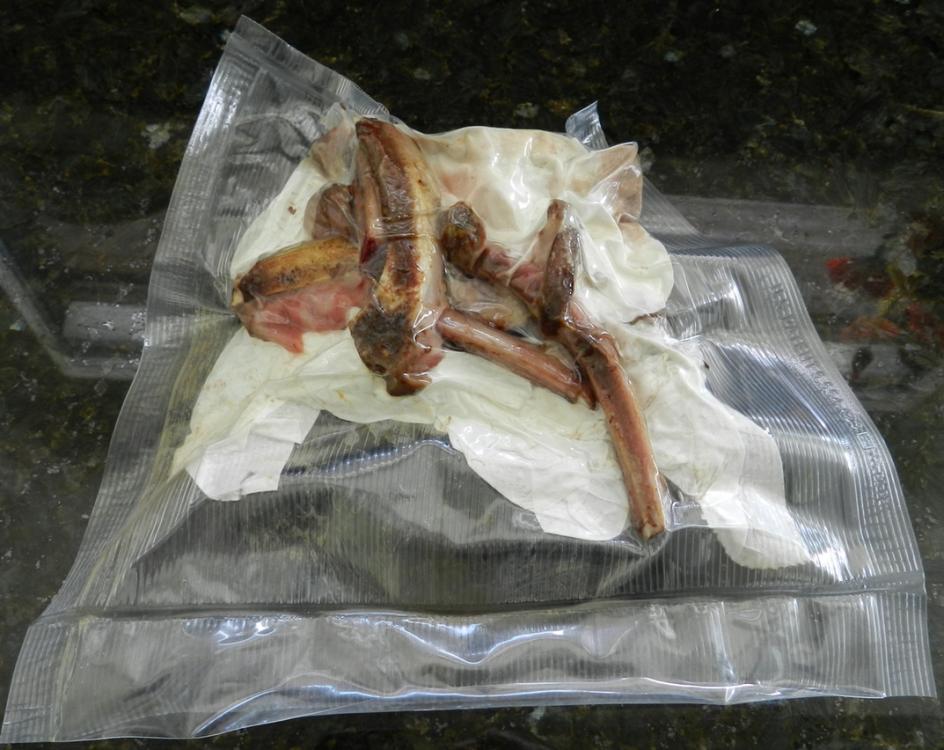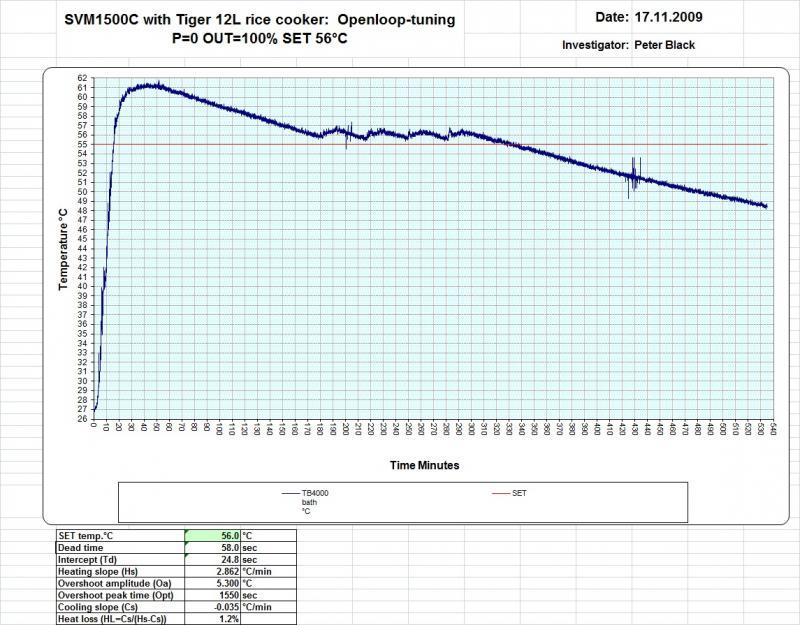-
Posts
518 -
Joined
-
Last visited
Content Type
Profiles
Forums
Store
Help Articles
Everything posted by PedroG
-
Must be the New chef touch cooking system from Kitchen Aid including the KitchenAid KOCV3610 Vacuum Machine, a combi steamer oven and a shock freezer. See also http://blog.medellit...em-pricing.html and http://www.sousvidec...rom-kitchenaid/. Seems to have been marketed at about USD 17'500 two years ago (that's one hundred SideKICs!). Cooking SV in a steam oven is never as reliable as in a water bath, but to my knowledge some restaurants do so.
-
Try it and let us know what you think! Osso Bucco is something I tried sous vide, for 24 hours @ 58C I think, and I found the result a bit underwhelming- meat was fine but the sauce seemed to lack flavour. I recently bought a pressure cooker and tried osso bucco, and had a pretty amazing result in less than an hour - the sauce was rich and dark. It made me think I should try it sous vide again to compare the difference, maybe I need to do it for less time at a higher temperature. In my ossobuco recipe I recommended SV 24-36 hrs. at 58.5°C / 137°F for medium (alternatively 6-12 hrs. at 77°C / 173°F for well-done). Looking up my cooking notes, I found that 12h/58.5°C came out pink and fork-tender, but rather like a steak; later I preferred 24h / 58.5°C. Note also that the sauce in sous vide variations of traditional braise recipes is missing the Maillard products from pre-searing the meat. This may be overcome by searing a small amount of ground meat mixed with some flour (and eventually condiment) before sautéing the onions and other ingredients.
-
Sorry for my ignorance Pedro ...but does this works? Is it noticeable over a flat 60ºc profile? How does it compares with classic aging ? Regards David I didn't do any systematic comparison between meat cooked to e.g. 55oC with / without turbo-aging. According to J. J. Wu, T. R. Dutson, Z. L. Carpenter: Effect of Postmortem Time and Temperature on the Release of Lysosomal Enzymes and Their Possible Effect on Bovine Connective Tissue Components of Muscle, more lysosomal glycosidases are released at 37oC than at 2oC, helping dissolution of collagen fibers by collagenase. According to D. J. ETHERINGTON; The Purification of Bovine Cathepsin B1 and its Mode of Action on Bovine Collagens, not only collagenases, but also certain cathepsins have collagenolytic activity. This might imply that by aging at 37oC or 45oC, not only muscle fibers are weakened, but also collagen may be dissolved. Instead of aging at a constant temperature, one might start with cold water and set the SV rig to heat slowly (e.g. 4h) up to 55oC by reducing output power, as I described in the PID tuning guide in chapter "Output Power Limit % (Level 3 parameter menu SLA)" on page 13-14. Unfortunately, there is a software bug in the SousVideMagic 1500D in software versions 4.0, 5.0 and 6.0 which I described here: SLA in level 3 parameter menu is max. output %, can be set from 20% to 100%, but below 60% there is no output at all. Here is a workaround:
-
That article compares apples with pears: pre-seared steaks against non-seared steaks without any Maillard crust instead of post-seared steaks with a crust that is not softened by subsequent cooking on low heat. The author is not even able to spell Justus von Liebig correctly ("Justus von Leibig"). Before I read McGee's On Food and Cooking (1984 edition) debunking Liebig's theory, my steaks cooked on high heat used to come out rather dry and not as tender as I would have liked. Now starting on low heat to reach core temperature (sous vide or indirect heat in the gas grill on low fire) and post-searing in a screaming hot skillet or on the gas grill's maximum flame, my steaks come out with a nice crust, tender and juicy and succulent. Liquid loss happens anyway, even in sous vide cooking, but enzymatic tenderization during slow heating and avoiding collagen shrinking by abrupt heating are the important factors influencing organoleptic outcome.
-
See my earlier post on MagicVac bags: they are multilayer PA/PE (polyamide as an oxygen and aroma barrier and polyethylene as a water vapor barrier and sealing layer). PA has a melting point around 240°C or higher, PE melts at 130-145°C. PA/PE is safe for boiling at 100°C, but not for sterilization at 121°C (bags for sterilizing are made of PA/PP or PET/PP). I have been using the MagicVac bags at 80°C for up to 5 hours and at 55-59°C for up to 72 hours without any problem.
-
Crouton: Does the Cabelas have a canister-adapter? Did you seal liquids with it?
-
Looks nice, but has one disadvantage: as the port for the canister adapter tube is inside the vacuum chamber, sealing liquids will be difficult if not impossible. The Magic Vac Elite is 9cm high.
-
If you don't want to wait until your oven is at maximum temperature for final browning, just use a weed burner as suggested by RyanC.
-
See the topic All about "sous-vide" eggs: egg shells may break, so either use a bath that's easy to clean (it's not worth ruining an IC or FMM), or place the eggs in a bag filled with hot water from the SV bath and suspend the bag on a skewer to avoid uncontrolled movements and to make retrieval easier. For hard eggs with a slightly creamy yolk you might use the delta-T method described in the sous vide page of wikiGullet, cooking at 75°C for the time required for the yolk to reach the desired consistency, then setting the white in boiling water. Note that the times in Douglas Baldwin's table are not valid when setting the white beforehand, as thermal diffusivity of set egg white is different from (i.e. lower than in) liquid egg white.
-
Today's rack of lamb 3h/56°C was perfectly pink, fork-tender and succulent as always. And here's the trick how to dispose of the bones avoiding crows and foxes to forage in the garbage bag: vacuum-seal them in the used bag including the paper towels used to dab dry!
-
There might be a few "dumb" portable induction hubs out there with mechanical controls, see Viking - Portable Induction Cooker and Manual Control Countertop Induction Cooker (120V) If you really encounter a dumb induction hob, I guess it would make a very responsive (low thermal inertia) system similar to an immersion heater like FMM. If you can get one, please post your experiences here. But before buying make sure it heats after power OFF/ON.
-
See FDA's Refrigerator & Freezer Storage Chart -> 7 days will be OK in the fridge.
-
According to FDA’s bad bug book, freezing fish for at least 7 days at or below -20°C/-4°F will kill parasites like Anisakis (but not bacteria), and it should not deteriorate texture significantly; you might eventually freeze before vacuum-sealing if you use vacuum levels as high as the ones produced by chamber machines to avoid deterioration of texture. When using Douglas Baldwin’s table for heating meat from frozen, add some safety margin, as he used a thermal diffusivity of 1.4×10-7 m2/s in contrast to the thermal diffusivity of 0.995×10-7 m2/s he used in the tables for pasteurizing fish from 5°C. For pasteurizing, first thaw, e.g. in a 0-1°C water pot in the fridge.
-
To give you an idea how fast a rice cooker will lose temperature, I show you the diagram of an open loop tuning experiment from blackp (back in 2009 Robert Jueneman and blackp and I conducted experiments to compare different cookers controlled by an SVM): This shows you that a well insulated rice cooker may lose in the range of 2.0 - 2.5 °C per hour. So to drop the temperature from 60°C to 53°C (the upper limit of growth of Clostridium perfringens) it would have taken roughly 3 hours, and if power outage in the worst case had been 6.5 hours (11pm till 5:30am), you were less than 4 hours in the "danger zone". Edit: I just read that your power outage was 3 hours or less, so you are definitely on the safe side.
-
Remember last April's discussion The vacuum level dilemma with chamber sealers for sous vide cooking and an earlier post on floating bags. With residual air from low vacuum levels in a chamber vac, or with fatty food, use marbles or glass beads in the bag and skewer suspension to avoid floating. For delicate food like fish you might use an edge sealer or Ziploc bags instead of a chamber vac.
-
I bought my 220V Elite Magic Vac (made in Italy) back in 2000, and after 12 years of daily use it is still going strong, and it is suitable for sealing liquids. It seems to be available also in the 110V-world at $139.95 here or here, or google "Elite Magic Vac".
-
Maybe they have 110V machines only. Why not buy in Europe, e.g. Vac-Star?
-
Floating Balls for Sous Vide Baths r = radius F = surface of cirmumscribed hexagon F = r² * tg(30°) * 6 r = sqrt(F / 6 / tg(30°)) Polyscience: 400 balls à 20mm Ø (r=1cm) = $99 400 * 1 * tg(30°) * 6 = 1385 cm² -> $0.07 / cm² VacStar: 100 balls for GN ½ container = CHF 30 = $33.50 GN ½ = 26.5 * 32.5 cm = 861 cm² Ball-Ø = 2 * sqrt(8.61/6/tg(30°)) = 3.15cm -> $0.04 / cm² Ping Pong Balls: Ball-Ø 40mm (r=2cm) (before year 2000 38mm) amazon.com: 144 balls = $12 144 * 2 * tg(30°) * 6 = 997.7 cm² -> $0.012 / cm²
-

"Sous Vide for the Home Cook" by Douglas Baldwin
PedroG replied to a topic in Cookbooks & References
The "danger zone" Be aware that (see the wikiGullet article on the Danger Zone).So holding ground beef at 10°C/50°F is not nearly as dangerous as holding it at e.g. 40°C/104°F. On the other hand, holding fish at 4.0°C/39°F, i.e. below the "danger zone" won't keep it fresh. Fish living in arctic seawater have (autolytic and other) enzymes and may harbor microbes adapted to temperatures down to -1.9°C/28.6°F (freezing point of seawater), so they are more susceptible to spoilage even at refrigerator temperatures of 4.4°C/40°F; it is preferable to store fish on crushed ice and eat it before it eats itself. -
See in the main SV topic egullet.org/p1859926: and wait for nickrey's report.
-
M61376, I got my VP112 yesterday and let me tell you it's a beast. I cleared a space for it in my pantry but it is too long for the cabinet top. (the top is only 16 inches deep) I don't know what I'm going to do with the monster but I LOVE the thing and I have only used it once! The weight is manageable for me but I don't think my wife would be able to muscle it around and I'd hate to think about dropping it! These are all minor issues to me considering what it can do. Thanks- that's what I was afraid of. My dreams are crushed, although it would be a good excuse to redo the kitchen :-) I guess I'll just have to settle for the ziploc bags when using marinades. See upthread and here how to seal liquids using an edge sealer, no need for a chamber machine. If your marinade is rather creamy than liquid, wrapping in cling film before bagging will do.
-
See the Wikipedia article on cooking off alcohol and the USDA Table of Nutrient Retention Factors (page 12, retention codes 5001-5010) -> it takes many hours to cook off most of the alcohol in a sauce, after 2.5hr cooking there is still 5% of the alcohol retained.
-
See www.douglasbaldwin.com/sous-vide.html#Marinating_Tenderizing_and_Brining:
-
MY concern with that method is that the whole bag is not under water, meaning that if there was any of the meat that rubbed on an area of the bag that doesn't end up underwater and you go for a super long cook time, it's possible that any bacteria will multiple and recontaminate your now pasteurized meat. I always make sure the bags are fully submerged. Like with my comment on storing liquid in bags, you leave a long tail. I believe Pedro also seals marbles in the bags to make sure they keep submerged. I thought Pedro's hanger method the top of the bag is out of the water hanging from a hanger? Adjust the geometry of your skewer and the filling level of the pot so that the whole bag or at least the seal is sure to be under water even with some evaporation when cooking for 48-72h. I bend my skewers from 3mm stainless steel wire, and with a file or rasp I make a sharp spearhead allowing easy piercing of the bag.
-

"Modernist Cuisine" by Myhrvold, Young & Bilet (Part 3)
PedroG replied to a topic in Cookbooks & References
See modernistcuisine.com/2011/12/foreign-editions-are-in-stock/, available at 399 EUR (about 520 USD) in French, German and Spanish. Amazon.com has the Spanish edition at 562.50 USD.





